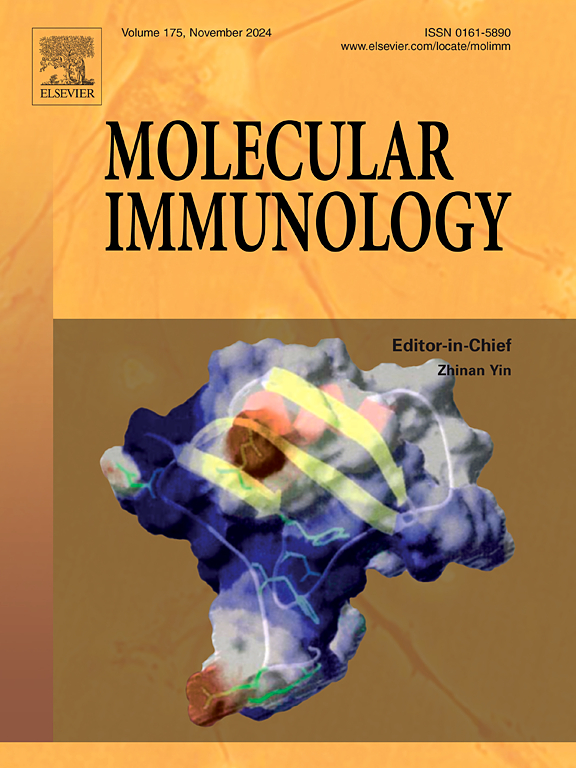KRT14是一种很有前景的与免疫浸润相关的乳腺癌预后生物标志物
IF 3.2
3区 医学
Q2 BIOCHEMISTRY & MOLECULAR BIOLOGY
引用次数: 0
摘要
乳腺癌(BC)是全球妇女的主要癌症,在100多个国家中发病率和死亡率最高。本研究旨在发现一种新的预后生物标志物,促进个性化治疗方法。方法从Cancer Genome Atlas数据库和Gene Expression Omnibus数据库下载srna测序数据,评估Keratin 14 (KRT14)的表达水平和预后意义。KRT14的甲基化也被评估。采用CIBERSORT和单样本基因集富集分析算法探索KRT14与肿瘤微环境之间的联系。通过“prophytic”R包和Connectivity Map分析原药的敏感性和潜在的小分子治疗化合物。通过免疫组化比较肿瘤周围和癌组织中的蛋白水平,进一步证实了KRT14的预后价值。此外,为了提高对BC患者预后的预测准确性,我们设计了基于KRT14的免疫相关预后模型。结果研究发现,KRT14在BC中普遍下调表达,与预后不良密切相关。与正常组织相比,BC组织中KRT14的甲基化水平更高。KRT14的低表达与抗肿瘤免疫细胞浸润减少和免疫抑制细胞浸润增加有关。KRT14表达降低组对各种关键治疗药物的敏感性较低。此外,还鉴定了几种潜在的抗bc小分子化合物。与仅基于KRT14表达水平的预测相比,本研究设计的模型显著提高了对BC患者的预测能力。结论总的来说,KRT14与BC的预后密切相关,是一个可靠的生物标志物。本文章由计算机程序翻译,如有差异,请以英文原文为准。
KRT14 is a promising prognostic biomarker of breast cancer related to immune infiltration
Background
Breast cancer (BC) is the leading cancer among women globally, which has the highest incidence and mortality rate in over a hundred countries. This study was intended to discover a new prognostic biomarker, facilitating personalized treatment approaches.
Methods
RNA sequencing data from The Cancer Genome Atlas database and Gene Expression Omnibus database were utilized to download to evaluate expression levels and prognostic significance of Keratin 14 (KRT14). Methylation of KRT14 was also assessed. The CIBERSORT and single-sample gene set enrichment analysis algorithms were applied to explore the connection between KRT14 and the tumor microenvironment. Primary drugs' sensitivity and potential small molecule therapeutic compounds were analyzed through the "pRRophetic" R package and the Connectivity Map. The prognostic value of KRT14 was additionally corroborated through a comparison of protein levels in peritumoral and cancerous tissues via immunohistochemistry. Moreover, an immune-related prognostic model based on KRT14 was designed to enhance the prediction accuracy for the prognosis of BC patients.
Results
The study found that KRT14 expression was generally downregulated in BC, correlating strongly with poor prognosis. Compared to normal tissues, the methylation level of KRT14 was higher in BC tissues. Lower expression of KRT14 was linked to decreased anti-tumoral immune cells infiltration and increased immunosuppressive cells infiltration. Sensitivity to various key therapeutic drugs was lower in groups with diminished KRT14 expression. In addition, several potential anti-BC small molecule compounds were identified. The model designed in this study significantly enhanced the predictive capability for BC patients compared to predictions based solely on KRT14 expression levels.
Conclusion
Overall, KRT14 was closely correlated with the prognosis in BC, making it a reliable biomarker.
求助全文
通过发布文献求助,成功后即可免费获取论文全文。
去求助
来源期刊

Molecular immunology
医学-免疫学
CiteScore
6.90
自引率
2.80%
发文量
324
审稿时长
50 days
期刊介绍:
Molecular Immunology publishes original articles, reviews and commentaries on all areas of immunology, with a particular focus on description of cellular, biochemical or genetic mechanisms underlying immunological phenomena. Studies on all model organisms, from invertebrates to humans, are suitable. Examples include, but are not restricted to:
Infection, autoimmunity, transplantation, immunodeficiencies, inflammation and tumor immunology
Mechanisms of induction, regulation and termination of innate and adaptive immunity
Intercellular communication, cooperation and regulation
Intracellular mechanisms of immunity (endocytosis, protein trafficking, pathogen recognition, antigen presentation, etc)
Mechanisms of action of the cells and molecules of the immune system
Structural analysis
Development of the immune system
Comparative immunology and evolution of the immune system
"Omics" studies and bioinformatics
Vaccines, biotechnology and therapeutic manipulation of the immune system (therapeutic antibodies, cytokines, cellular therapies, etc)
Technical developments.
 求助内容:
求助内容: 应助结果提醒方式:
应助结果提醒方式:


